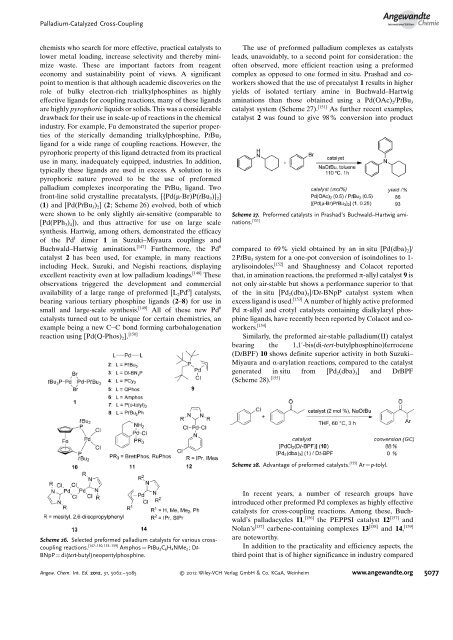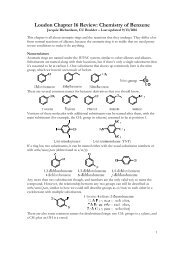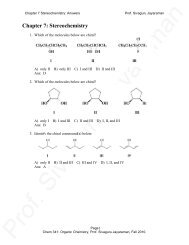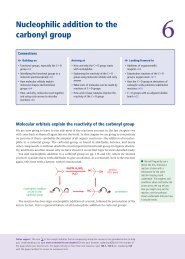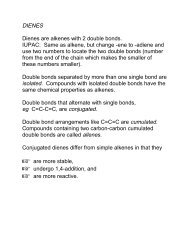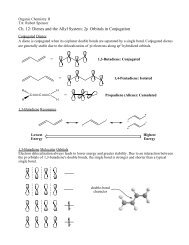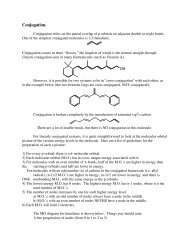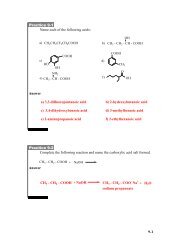Palladium-Catalyzed Cross-Coupling - A Historical Contextual Perspective to the 2010 Nobel Prize
Palladium-Catalyzed Cross-Coupling - A Historical Contextual Perspective to the 2010 Nobel Prize
Palladium-Catalyzed Cross-Coupling - A Historical Contextual Perspective to the 2010 Nobel Prize
You also want an ePaper? Increase the reach of your titles
YUMPU automatically turns print PDFs into web optimized ePapers that Google loves.
<strong>Palladium</strong>-<strong>Catalyzed</strong> <strong>Cross</strong>-<strong>Coupling</strong>AngewandteChemiechemists who search for more effective, practical catalysts <strong>to</strong>lower metal loading, increase selectivity and <strong>the</strong>reby minimizewaste. These are important fac<strong>to</strong>rs from reagenteconomy and sustainability point of views. A significantpoint <strong>to</strong> mention is that although academic discoveries on <strong>the</strong>role of bulky electron-rich trialkylphosphines as highlyeffective ligands for coupling reactions, many of <strong>the</strong>se ligandsare highly pyrophoric liquids or solids. This was a considerabledrawback for <strong>the</strong>ir use in scale-up of reactions in <strong>the</strong> chemicalindustry. For example, Fu demonstrated <strong>the</strong> superior propertiesof <strong>the</strong> sterically demanding trialkylphosphine, PtBu 3ligand for a wide range of coupling reactions. However, <strong>the</strong>pyrophoric property of this ligand detracted from its practicaluse in many, inadequately equipped, industries. In addition,typically <strong>the</strong>se ligands are used in excess. A solution <strong>to</strong> itspyrophoric nature proved <strong>to</strong> be <strong>the</strong> use of preformedpalladium complexes incorporating <strong>the</strong> PtBu 3 ligand. Twofront-line solid crystalline precatalysts, [{Pd(m-Br)P(tBu 3 )} 2 ](1) and [Pd(PtBu 3 ) 2 ](2; Scheme 26) evolved, both of whichwere shown <strong>to</strong> be only slightly air-sensitive (comparable <strong>to</strong>[Pd(PPh 3 ) 4 ]), and thus attractive for use on large scalesyn<strong>the</strong>sis. Hartwig, among o<strong>the</strong>rs, demonstrated <strong>the</strong> efficacyof <strong>the</strong> Pd I dimer 1 in Suzuki–Miyaura couplings andBuchwald–Hartwig aminations. [147] Fur<strong>the</strong>rmore, <strong>the</strong> Pd 0catalyst 2 has been used, for example, in many reactionsincluding Heck, Suzuki, and Negishi reactions, displayingexcellent reactivity even at low palladium loadings. [148] Theseobservations triggered <strong>the</strong> development and commercialavailability of a large range of preformed [L 2 Pd 0 ] catalysts,bearing various tertiary phosphine ligands (2–8) for use insmall and large-scale syn<strong>the</strong>sis. [149] All of <strong>the</strong>se new Pd 0catalysts turned out <strong>to</strong> be unique for certain chemistries, anexample being a new C C bond forming carbohalogenationreaction using [Pd(Q-Phos) 2 ]. [150]The use of preformed palladium complexes as catalystsleads, unavoidably, <strong>to</strong> a second point for consideration: <strong>the</strong>often observed, more efficient reaction using a preformedcomplex as opposed <strong>to</strong> one formed in situ. Prashad and coworkersshowed that <strong>the</strong> use of precatalyst 1 results in higheryields of isolated tertiary amine in Buchwald–Hartwigaminations than those obtained using a Pd(OAc) 2 /PtBu 3catalyst system (Scheme 27). [151] As fur<strong>the</strong>r recent examples,catalyst 2 was found <strong>to</strong> give 98% conversion in<strong>to</strong> productScheme 27. Preformed catalysts in Prashad’s Buchwald–Hartwig aminations.[151]compared <strong>to</strong> 69% yield obtained by an in situ [Pd(dba) 2 ]/2PtBu 3 system for a one-pot conversion of isoindolines <strong>to</strong> 1-arylisoindoles, [152] and Shaughnessy and Colacot reportedthat, in amination reactions, <strong>the</strong> preformed p-allyl catalyst 9 isnot only air-stable but shows a performance superior <strong>to</strong> tha<strong>to</strong>f <strong>the</strong> in situ [Pd 2 (dba) 3 ]/Dt-BNpP catalyst system whenexcess ligand is used. [153] A number of highly active preformedPd p-allyl and crotyl catalysts containing dialkylaryl phosphineligands, have recently been reported by Colacot and coworkers.[154]Similarly, <strong>the</strong> preformed air-stable palladium(II) catalystbearing <strong>the</strong> 1,1’-bis(di-tert-butylphosphino)ferrocene(DtBPF) 10 shows definite superior activity in both Suzuki–Miyaura and a-arylation reactions, compared <strong>to</strong> <strong>the</strong> catalystgenerated in situ from [Pd 2 (dba) 3 ] and DtBPF(Scheme 28). [155]Scheme 28. Advantage of preformed catalysts. [155] Ar = p-<strong>to</strong>lyl.Scheme 26. Selected preformed palladium catalysts for various crosscouplingreactions. [147–150, 153–159] Amphos = PtBu 2 C 6 H 4 NMe 2 ;Dt-BNpP = di(tert-butyl)neopentylphosphine.In recent years, a number of research groups haveintroduced o<strong>the</strong>r preformed Pd complexes as highly effectivecatalysts for cross-coupling reactions. Among <strong>the</strong>se, Buchwaldspalladacycles 11, [156] <strong>the</strong> PEPPSI catalyst 12 [157] andNolans [137] carbene-containing complexes 13 [158] and 14, [159]are noteworthy.In addition <strong>to</strong> <strong>the</strong> practicality and efficiency aspects, <strong>the</strong>third point that is of higher significance in industry comparedAngew. Chem. Int. Ed. 2012, 51, 5062 – 5085 2012 Wiley-VCH Verlag GmbH & Co. KGaA, Weinheim www.angewandte.org5077


